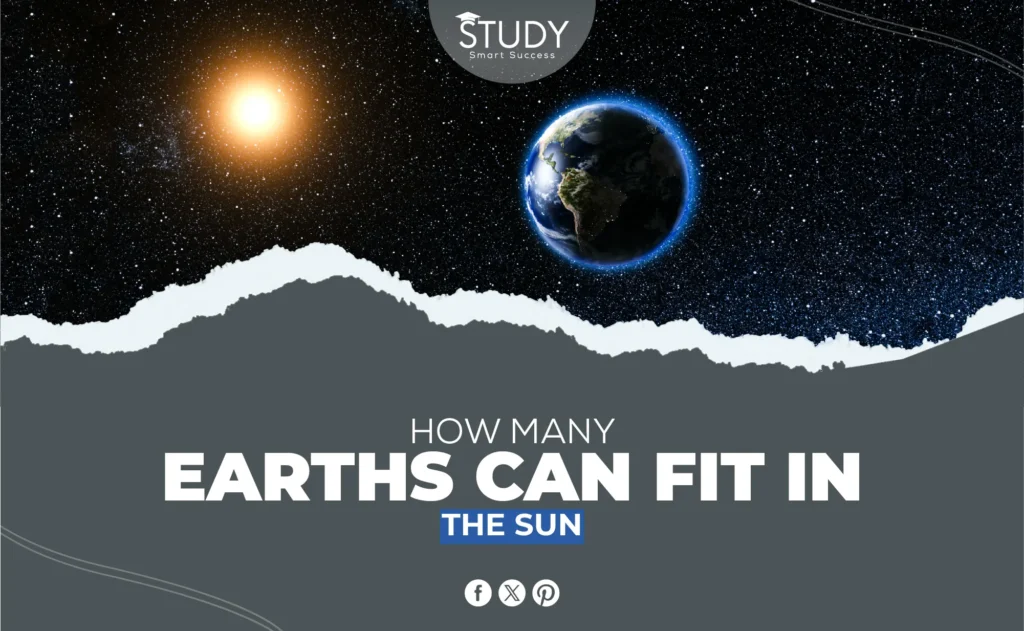Introduction
This awe-inspiring cosmic excursion shows the grandeur of our solar system. As we orbit the Sun, it’s easy to miss its massive magnitude compared to Earth’s familiar topography. This blog explores celestial dimensions, making analogies that challenge our size perceptions. Explore these cosmic wonders to learn how many Earths can fit in the Sun.
Volume, mass, and the gravitational ballet harmonizing our planetary neighborhood, not just distances and diameters, are discussed here. By juxtaposing the massive Sun with our little planet Earth, we hope to highlight the scale disparities and increase our understanding of the dynamic system that sustains life.
Understanding the relationships between these celestial giants illuminates our place in the universe. It’s about comprehending space, gravity, and the forces that shape us, not simply numbers. Join us as we compare our planet to the Sun, the energy source of our solar system.
Sizes of The Sun and Earth
As we glance up, the sun and moon appear identical in size. However, their scales and distances are staggering. This blog post will explain the Sun and Earth’s basic dimensions to help you visualize their sizes.
Sun’s Dimensions
- Diameter: It’s about 1.4 million kilometers (870,000 miles) across the Sun. This huge size, which makes it about 109 times wider than Earth, shows how huge it is compared to our world.
- Circumference: The Sun’s circle around the equator is about 4.37 million kilometers (2.72 million miles) wide. This huge distance shows how big the Sun’s upper layer is, sending energy and light around the solar system.
- Volume: The Sun has an amazing amount of about 1.4 x 10^18 cubic kilometers. To give you an idea of how big that is, over 1.3 million Earths could fit inside the Sun. This shows how much room it takes up in the solar system.
- Mass: The Sun weighs about 2 x 1030 kilograms, which is 330,000 times more than Earth. Because it has such a huge mass, it has a strong gravitational pull that keeps the planets and other celestial objects in orbit and keeps our solar system stable.
Earth’s Dimensions
- Diameter: The Earth’s surface is about 12,742 kilometers (7,918 miles) across, so it has many different climates and habitats.
- Circumference: The circle of the equator is 40,075 kilometers (24,901 miles), giving Earth many time zones and lots of sunlight.
- Volume: Earth, with a volume of 1.1 x 10^12 cubic kilometers, maintains massive oceans, mountain ranges, and subsurface systems despite its small size relative to the Sun.
- Mass: Earth, with a mass of 5.97 x 10^24 kilograms, has a magnetic field that shields it from damaging solar radiation, allowing it to maintain an atmosphere and support life, unlike most known planets.
Comparing these dimensions shows how massive the Sun is compared to Earth. Gravitational forces, solar radiation, and Earth’s orbit are all affected by this scale. These fundamental measurements help us understand our solar system’s physical makeup and celestial forces.
Volume Comparison: Earth vs. The Sun
When comparing the sizes of celestial things like the Sun and Earth, it’s important to understand what volume means. Volume is a key way to figure out how big these huge things really are because it measures how much space an object takes up.
Explanation of Volume
The shape of an item affects how its volume is calculated in different ways, but the Earth and the Sun can both be thought of as spheres. To find the volume of a sphere, use the following formula:
V = 4/3 πr³
Where r is the sphere’s surface area. With this formula, we can figure out how much three-dimensional room each celestial body takes up.
Mathematical Calculation of the Sun’s Volume Versus Earth’s Volume
Let’s figure out how big Earth and the Sun are compared to each other to better understand the huge difference in size:
- Radius of the Earth: Approximately 6,371 kilometers (3,959 miles).
- Radius of the Sun: Approximately 700,000 kilometers (435,000 miles).
Using the volume formula:
The volume of the Earth:
Volume of Earth = 34 π(6,371 km)³ ≈ 1.1 x 1012 km³
The volume of the Sun:
Volume of Sun = 34π(700,000 km)³ ≈ 1.4 x 1018 km³
Comparison
Now, comparing these volumes:
Volume of Earth and Volume of Sun ≈ 1.1 x 10121.4 x 1018 ≈ 1.3 million Earths
The star at the center of our solar system is far larger than our planet, as shown by this estimate. The Sun can accommodate 1.3 million Earths, demonstrating its massive size. These statistics show how big our Sun is and how big the universe is.
How Many Earths Can Fit in the Sun?
How many Earths could fit within the Sun is a startling way to appreciate its grandeur. This comparison shows how big our star is and how little our planet is in the universe.
Calculations of Fitting Earth into the Sun
We use the formula for sphere volume to calculate how many Earths can fit within the Sun
V = 4/3 πr³
Steps:
Radius of the Sun: Approximately 700,000 kilometers.
Radius of Earth: Approximately 6,371 kilometers.
Volume of Sun = 34π (700,000 km)³ ≈ 1.4 x 1018 km³
Volume of Earth = 34 π(6,371 km)³ ≈ 1.1 x 1012 km³
Earths in the Sun = Volume of Earth x Volume of Sun ≈ 1.1 x 10121.4 x 1018 ≈ 1.27 million
This calculation shows that 1.27 million Earths could fit within the Sun, demonstrating its massive size.
Visualizing the Size Difference
The following images can help you picture this huge difference in size:
- Scale Image: Think of the Sun as a big exercise ball about 2.5 feet across. On the other hand, Earth would be a very small bead, only 0.25 inches across.
- Volume Representation: If you could fill that big box with more than a million rocks the size of Earth, it would be the size of the Sun.
These images show how big the Sun is compared to Earth. This scale humbles us and highlights the grandeur of cosmic occurrences.
Implications of the Size Difference Between the Sun and Earth
The sun’s massive size amazes and affects the dynamics of the solar system. Understanding how the Sun’s massiveness affects solar and planetary events might illuminate numerous cosmic phenomena.
Effects on Solar and Planetary Phenomena
Solar Activity
- Solar Flares and Coronal Mass Ejections: Solar flares result from the Sun’s massive energy and size. They unleash massive amounts of energy and charged particles that can affect geomagnetic storms and satellite operations.
- Sunspots: These transient Sun photosphere events appear darker than the surrounding area. The Sun’s immense size and complicated magnetic structure create magnetic field interactions.
Solar Wind
- Stream of Charged Particles: The solar wind, charged particles from the Sun, streams throughout the solar system. The solar wind creates a solar-dominated bubble in space throughout the heliosphere.
Gravitational Pull and Its Impact
The solar system is held together by the Sun’s gravity. Because it is so big, it has a very strong gravity pull that has several important effects:
- Orbital Stability: The planets move around the Sun because it pulls on them. The stable pull of the Sun’s gravity allows these planets to follow regular paths.
- Tides on Earth: Even though the Moon impacts Earth’s tides most, the Sun’s gravitational pull is also very important.
- Planetary Formation and Debris Clearance: Material accreted during the solar system’s creation due to the Sun’s gravity. It affects comet and asteroid courses, removing trash from the solar system’s early days.
Understanding the Sun’s magnitude helps us understand its physical properties and the solar system’s dynamic activities. This massive celestial body affects space weather and our planet’s stability, not just size.
Conclusion
Let’s review the Sun’s massive size relative to Earth and consider the universe’s ramifications as we conclude.
The Sun can accommodate 1.27 million Earths and is 109 times the diameter of Earth. Understanding solar physics and cosmic dynamics requires this massive magnitude. The Sun’s size causes flares, coronal mass ejections, and solar wind, which shape the solar system. The solar system relies on gravity to stabilize planet orbits and control their internal and atmospheric processes.
The comparison between Earth and the Sun shows the universe’s intricacy and majesty, making us appreciate life’s delicate balance and fine-tuning. The Sun’s immense size affects day and night cycles, climate, and weather, emphasizing the importance of researching the cosmos. These discoveries remind us that we are part of a vast, dynamic, and ever-changing cosmos, enriching our lives and aspirations.
The size of the Sun compared to Earth shows the wonders of astronomy and our universe. It inspires astonishment and respect for the forces that rule and drive us to explore space.


